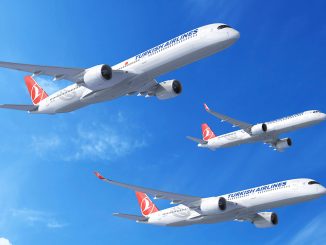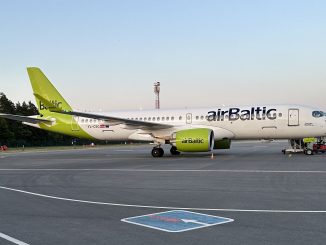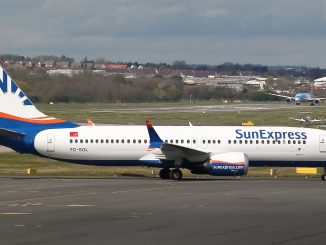
Novespace is a subsidiary of CNES (Centre national d’études spatiales), the French national space agency, which operates the aircraft for research agencies from all over the world, with the majority of studies being conducted through CNES, the German Space Agency (DLR – Deutsches Zentrum für Luft- und Raumfahrt) and ESA (European Space Agency).

It operates parabolic flights to simulate microgravity – Zero G. A parabola is the manoeuvre in which the aircraft is flown through which it can generate a zero G environment on board. From the side profile, such a manoeuvre resembles that of a sine wave.
Dr. Katrin Stang, the Parabolic Flight Programme Manager at DLR explained how there is a strict criteria for projects to be accepted on board a Novespace flight. In the case of Germany, the research organisation or university will approach the DLR and Dr. Stang to express interest in flying the experiment in Zero G. They will then evaluate whether it is the right platform for the experiment. Upon successful evaluation, the experiment will be green-lit and a nine-month campaign preparation phase begins.
Two weeks before the campaign flies, the experiment is moved to Bordeaux to be safety checked and loaded onto the aircraft.
“We have around ten to 13 experiments that we can fly on one plane, coming from all disciplines of research: human researches, sports medicine, biology, technology, fundamental physics and also material sciences.” Explains Dr. Stang. The campaign will then fly three parabolic flights, each of 31 parabolas, “…allowing the scientists to cumulate 30-35 minutes of microgravity time.”
In addition to scientific flights, Novespace offers approximately 10% of its flights to the public, of whom a small group can book a flight of 16 parabolas.
Background of the aircraft
Novespace operates a single Airbus A310-304, which it uses to conduct parabolic flights, allowing researchers the opportunity to conduct scientific experiments in a zero G, contactless environment. The aircraft, registered as F-WNOV, was originally delivered to the then East German state airline Interflug, in June of 1989.
Upon the collapse of the GDR (German Democratic Republic) and German reunification, it was transferred to the Luftwaffe/German Air Force in October of 1991, where it was used for medivac and personnel transport purposes until it’s acquisition by Novespace in March of 2015. It replaced an Airbus A300, which Novespace had previously operated since 1997.
When asked why this specific airframe was chosen to replace the A300, test pilot Stephane Pichene explained that the aircraft was well maintained and also relatively young in terms of flight cycles and hours, with approximately 20,000 flight hours.
How this aircraft differs from any other Airbus A310
The aircraft is almost entirely standard, with the exception of some modifications to the cockpit. It also has 8 power converters in the forward cargo hold which provide the electrical power to the scientific experimentation equipment that may be fitted on board, however Pichene clarified that these aren’t seen as a modification, rather just payload.
On the flight deck, there are a small number of additions to the instrumentation. Hyper-sensitive digital accelerometer displays, which allow for precise measurement of G forces, swivel out in front of the analogue backup airspeed and heading gauges. There is also a far less accurate analogue backup G meter gauge installed on the far outer end of of the main control panel.

The control columns are fitted with a modified, detachable yoke which allows for the pitch to be controlled without being able to make any changes to the roll of the aircraft. On the other yoke, there are two very low-tech small fabric loops, which allow the other pilot to control the roll without affecting the pitch.

Additionally, there is a small wooden block which is placed between the idle stop of the thrust levers and the levers themselves during parabolic manoeuvres. This artificially limits the minimum position of the thrust levers to approximately 7% above idle.

How a parabolic flight is conducted
The aircraft is flown in a totally conventional, two crew manner (with a Pilot Flying and a Pilot Monitoring) from its base in Bordeaux to the area where the tests are to be conducted. This is normally in a north-western corridor (from Bordeaux) over the Atlantic or, on occasion, over the Mediterranean Sea. These locations are chosen due to their typically favourable weather conditions and air traffic volume.
Each flight is flown with a flight crew of four; three of whom are required for performing the parabolas, and they each rotate around the cockpit to perform the different roles, with one always in the jump seat, essentially as a passenger.
During the parabolic stages of flight, a number of systems related to the flight controls are disabled, for example the auto trim computers, in order to grant the crew more manual control during the unconventional manoeuvre.
Once the aircraft is in position and ready for the parabolic experiments to take place, the cockpit responsibilities change significantly. One pilot is responsible solely for the pitch of the aircraft and talking with air traffic control (ATC), the second pilot is then looking after only the roll (maintaining wings level) of the aircraft and also the public address system to advise the scientists in the cabin as to the phases of flight for the experiments. Meanwhile, the third pilot manages the thrust – with the now aforementioned wooden stop in place. During this phase of flight the aircraft will be assigned it’s own ATC frequency which is left mostly silent to allow the crew to focus on the highly precise nature of the job at hand.
The aircraft will accelerate on the straight and level at full power up to 340 knots, then pitch up with approximately 1.8G up to 50 degrees nose up, whilst maintaining full thrust. This is held until the point of injection – called so as the moment which pitch down movement is ‘injected’. At this point, the thrust is brought down to its artificial idle position and the pitch is maintained with forward control movements to bring the aircraft to zero-G.
The aircraft will follow a zero-G environment within an accuracy of +/- 100th of a G (using the accelerometer displays) on board for approximately 22 seconds, during which the aircraft will slow to 30-50 knots below its stall speed.
“At this point,” Stephane Pichene joked “…we don’t need the wings. If we could remove the wings it would be better! Weightless means no contact forces, we have contact force with gravity. Weightless doesn’t mean no gravity. The gravity is always here but it means you have removed all contact forces, so you are in free fall. But an aircraft is dedicated to generate contact forces – lift. The aircraft is very useful to bring you up to the injection point but once you are in the parabola you just want no wings!”
Once the airspeed reaches 180 knots – the maximum to avoid overspeeding the airframe – the crew will then coerce the plummeting jetliner out of its now 40 degree nose down position and back to level flight, during which the loads are between 1.3 and 1.8 Gs.
A parabola is typically initiated at 20,000ft, with the climb lasting around 20 seconds during which the aircraft will climb 5,000ft. From injection to recovery (the envelope in which zero-Gs are achieved, the aircraft will lose 3,000ft, and the entire manoeuvre uses a block of 8,000ft.
Research flights are conducted with 31 parabolas each, with guest/passenger flights flown performing 16 parabolas.
What these manoeuvres mean for maintenance
Maintenance of the aircraft is actually fairly conventional for an Airbus A310, with the only real difference being the intervals for certain components. Each parabola is counted as a single flight cycle of the airframe (one pressurisation and depressurisation of the cabin) equal to a full conventional flight from take-off to landing.
In this case, a single experimental parabolic flight (during which 31 parabolas are flown) is counted as 32 cycles. Certain components have an additional count factor, such as the engines and the wing roots, which are counted at roughly 1.5 cycles per parabola. Therefore the maintenance intervals of these components are naturally higher than other components.
When asked why the flights are conducted with specifically 31 parabolas, Stephane explained that it is actually a legacy carryover from the previous Airbus A300 aircraft, but also that beyond that, the maintenance requirements increase exponentially.
The Airbus A310 has a design limitation of approximately 40,000 flight cycles.
Future of the aircraft
When asked about what the future holds for the gracefully ageing jet, Novespace CEO Thierry Gharib explained that the aircraft is set to remain in active service with Novespace until 2030 to 2035, however the company has already started looking into future for the program.
“We have already started studies to replace the aircraft, so we have several aircraft in mind. It will be an Airbus, because we need big support from the manufacturer to make the studies and we’re close enough to Airbus, and I’m not sure other manufacturers would be able to offer this much support. We still don’t know which kind of Airbus.”
He went on to explain that they have a shortlist of aircraft types, which previously included the A380. However, although Airbus had (incredibly) performed parabolic flight tests with the A380, the platform was deemed too expensive to be suitable for Novespace. It would also have changed the entire model of the programme, as a single A380 flight would be able to contain experiments which the A310 conducts over an entire year.
This leaves the rest of the Airbus catalogue open to evaluation: “Remaining are the A320, A330, A340 and A350. At the time it would rather be a choice between A320 and A330. The A340 is not completely out, but that’s four engines and economically its maybe more expensive, but we have to study more because its a different kind of engines, less powerful engines so maybe its something to look at because they’re less expensive.”
Thierry finished by explaining that the A320 is viable because of it being smaller, fewer experiments can be loaded at a time. Therefore it can be offered at a lower price and flown more frequently with a lower number of experiments on board.
Whatever the future holds for the future of Air Zero G at Novespace, we will have to wait until at least 2030 to find out.
Matt is a Berlin-based writer and reporter for International Flight Network. Originally from London, he has been involved in aviation from a very young age and has a particular focus on aircraft safety, accidents and technical details.



